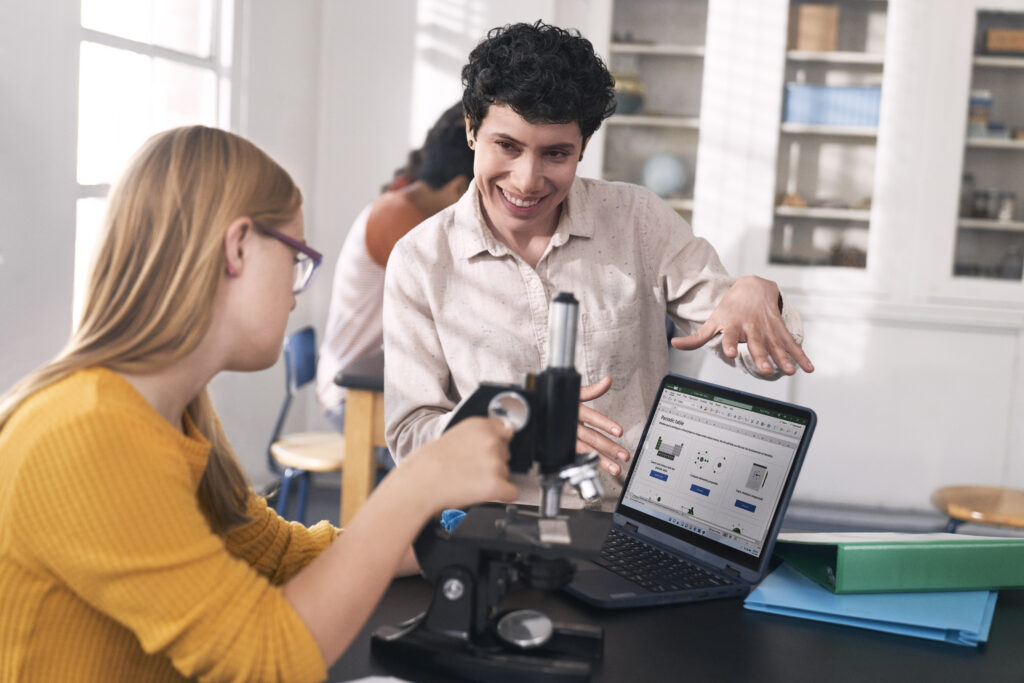
Education leaders on new teaching and learning technologies
America’s education systems have proven to be agile and resilient, but there is always room for transformative action and improvement. With the potential to change quickly and for the better, schools are currently working to make education more accessible, inclusive, and engaging for learners than ever before.
That’s why I’m excited to share Top Trends in Education, a series of conversations with some of our Microsoft education experts and leading industry thought leaders about digital equality, accessibility, and closing the skills gap.
Together, dedicated educators are driving innovation and digital transformation in schools to forge new paths toward excellence.
Making education more equitable through digital learning
Keith Krueger, CEO of the Consortium for School Networking, discusses digital learning. “One of the biggest hurdles currently facing American education is unequal access to resources,” says Krueger.
During periods of remote learning, some children fell behind their peers. This was due to a digital divide that overlaps poverty, race, ethnicity, and geography. For example, some homes didn’t have enough bandwidth or appropriate devices to support remote learning for everyone in the household.
Equity needs to be built into the foundations of education. “Ensuring that 60 percent or 80 percent or 90 percent of students could learn wasn’t good enough. We had to make sure that every student could,” says Krueger.
Besides technical access, quality education needs social connection and emotional well-being. People designing solutions for education must use technology to build rich digital ecosystems that enhance connectivity. These challenges call for leadership that looks toward the future.
Tune in to the conversation with Keith Krueger to learn how personalizing learning with technology is helping to bridge these gaps.
Audio description version: https://youtu.be/8f2X3a6CA2U
Personalized learning with Universal Design for Learning
The importance of inclusive design in creating accessible education is highlighted by Donna Murray. Murray is a Consultant for the Office of Digital Teaching and Learning at the North Carolina Department of Public Instruction.
One inclusive design, Universal Design for Learning (UDL), focuses on removing barriers to make education better for everyone.
In this framework, “disability” is essentially a mismatch between the learner and environment. UDL creates flexibility for students, using technology to give them choices about how they learn.
Teachers are also variable learners, so UDL is essential even when providing professional opportunities for educators. “Every student we have is a variable learner. When we focus on changing the environment rather than changing the learner, we really make learning more accessible,” says Murray.
This design must be embedded in education from the beginning rather than as an add-on. This requires shared decision-making and effective use of data to inform instruction and monitor learning.
Check out the interview with Donna Murray to learn more about how technology allows us to use data to personalize learning for all students.
Audio description version: https://youtu.be/gEgxs_WYNAw
Bridging the skills gap using technology in higher education
Jane Oates, President of WorkingNation, talks about how technology and lifelong learning are being used to address the skills gap. Technology evolves at a rapid pace, and higher education has had a difficult time keeping up. Learners are seeking accessible pathways to the relevant training and specific credentials they need for today’s tech jobs.
Because some skills needed today might be obsolete tomorrow, lifelong learning is vital. Technology must be part of the solution. Students of all ages want to learn in bite-size chunks precisely when they need it.
When 39 million people have some college education but no degree, it’s evident that more accessible models are urgently needed. This creates an opportunity to use technology to personalize higher education with a credential program.
Embedding vocational credentials in the college curriculum allows students to measure skills along the way. “This embedding does not dilute the academic education at all,” says Oates. “It just is sequencing courses in a way where students can see an earlier benefit rather than waiting for the final benefit of the degree.”
In this conversation with Jane Oates, dive deeper into ways to help underserved students, adult learners in need of upskilling, and professionals seeking tech qualifications.
Audio description version: https://youtu.be/zDxQA3si3mM
Including everyone in educational excellence
Educational excellence in 2023 and beyond will be defined by how equitably education helps students reach their best potential, regardless of wealth, ability, age, or stage of life. At Microsoft, we believe all learners deserve access to quality education, including best-in-class learning solutions and technologies.
Microsoft is committed to supporting equitable learning environments everywhere. We offer secure and trusted solutions that foster inclusivity and prepare all students for the future.
Learn more about Microsoft’s commitment to supporting education here: Technology Solutions for Schools | Microsoft in Education.




